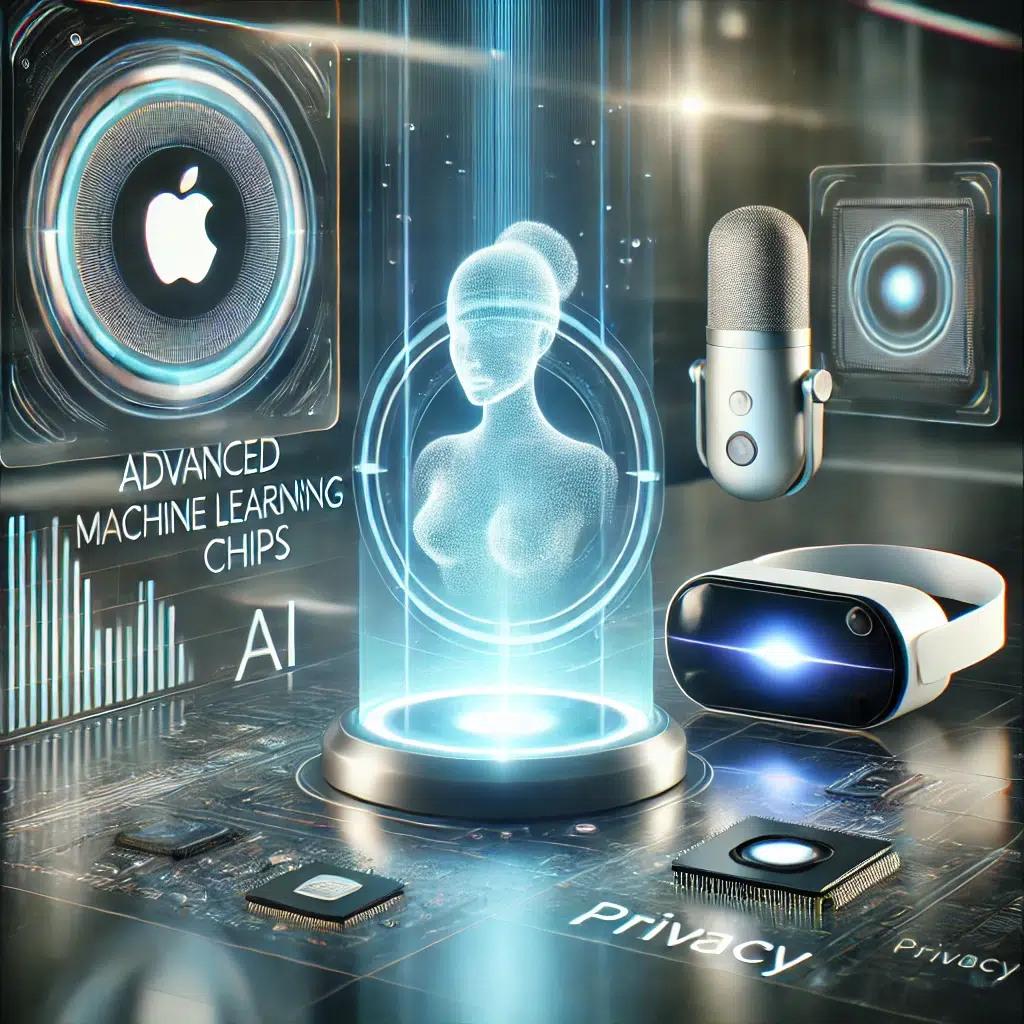Apple is no stranger to technological revolutions. With a legacy of groundbreaking innovations, the company is now doubling down on artificial intelligence (AI) to create smarter, more seamless, and privacy-centric experiences. Unlike competitors focused on large-scale generative AI models, Apple’s approach to AI emphasizes tight integration with its ecosystem, combining user-centric design, privacy safeguards, and cutting-edge hardware.
This article explores Apple’s latest developments in AI, shedding light on how the company is reimagining the future of technology while staying true to its core values.
The AI Vision: Seamless Integration Across Devices
Apple’s strategy in AI is uniquely integrated, prioritizing the enhancement of its devices and services over standalone AI solutions. Instead of releasing a single flagship AI product, Apple uses artificial intelligence to power features across its ecosystem, ensuring users experience smarter functionality without compromise.
Key areas of AI integration include:
- Siri Evolution: Apple’s voice assistant is becoming increasingly conversational and context-aware, leveraging on-device machine learning for faster responses.
- Photos App Intelligence: AI in the Photos app organizes memories, identifies objects and people, and even generates curated photo albums based on usage patterns.
- Live Text and Visual Look Up: Apple’s AI can recognize text in photos and provide actionable insights, such as copying numbers, translating languages, or identifying plants and animals.
Apple’s focus on on-device AI ensures users benefit from these innovations while their data remains private and secure.
Apple’s AI-Powered Hardware: The Game-Changer
One of the standout aspects of Apple’s approach to AI is its hardware-software synergy. The company’s proprietary hardware, like the Neural Engine in its A-series and M-series chips, is tailored to accelerate AI tasks.
Key Developments in Hardware for AI:
- A17 Pro Chip: Featured in the iPhone 15 Pro, this chip enhances real-time processing for features like computational photography, augmented reality (AR), and natural language recognition.
- M3 Chip Series: Designed for MacBooks, these chips optimize AI workloads, making tasks like video editing, rendering, and machine learning faster and more efficient.
- Apple Vision Pro: With advanced AI-powered sensors and processors, this mixed-reality headset redefines spatial computing, blending virtual and physical worlds.
Apple’s hardware advancements ensure its devices are AI-ready, offering powerful, efficient, and seamless AI experiences without relying heavily on cloud-based processing.
Generative AI: Apple’s Quiet Yet Powerful Entry
While companies like OpenAI and Google have been vocal about their generative AI breakthroughs, Apple has opted for a quieter but equally impactful approach. Reports suggest Apple is developing its own generative AI model, nicknamed “Ajax GPT,” which could rival existing solutions.
What We Know About Ajax GPT:
- Built in-house, Ajax GPT is expected to power a range of Apple services, including an enhanced Siri and smarter recommendations in apps like Messages and Mail.
- Focused on on-device generative AI, aligning with Apple’s privacy-first philosophy.
- Likely integrated into iCloud to enable secure, personalized generative AI experiences for users.
This approach highlights Apple’s long-term commitment to integrating generative AI into its ecosystem while maintaining user trust and privacy.
Privacy at the Core of Apple’s AI Strategy
Apple’s approach to AI stands apart due to its unyielding focus on privacy. In an era where data security concerns dominate conversations about AI, Apple has taken bold steps to ensure users feel secure while benefiting from advanced technology.
How Apple Safeguards Privacy in AI:
- On-Device Processing: Features like Siri and Face ID process data locally, ensuring sensitive information never leaves the user’s device.
- Differential Privacy: Apple anonymizes data before analyzing it, preventing any link between user identity and usage patterns.
- Transparency Reports: Users can review how their data is used across Apple services, reinforcing trust in the ecosystem.
This privacy-centric approach has not only differentiated Apple from its competitors but also strengthened its reputation as a brand that values user trust.
Apple Vision Pro: The AI-Driven Future of Spatial Computing
The Apple Vision Pro, slated for release in 2024, is Apple’s boldest step into the realm of AI-powered augmented and virtual reality. With its revolutionary interface, the device seamlessly blends the virtual and physical worlds, making it the perfect example of Apple’s AI philosophy.
AI Features in Vision Pro:
- Eye and Hand Tracking: AI interprets user gestures and gaze to create intuitive interactions, eliminating the need for physical controllers.
- Real-Time Environment Mapping: Vision Pro uses AI to analyze the user’s surroundings, creating immersive AR experiences tailored to the space.
- Enhanced Productivity: The device supports multitasking in virtual environments, powered by AI to boost efficiency and creativity.
Apple Vision Pro represents the culmination of years of AI research, bringing the company’s hardware and software prowess to the forefront of innovation.
The Competition: How Apple Stands Out in AI
Apple’s AI strategy might seem understated compared to companies like Google, Microsoft, and OpenAI, but it’s uniquely effective. Here’s how Apple differentiates itself:
| Feature | Apple | Competitors (Google, OpenAI) |
|---|---|---|
| Focus | User experience and privacy | Cloud-based AI models |
| Hardware Optimization | Proprietary chips (Neural Engine) | General-purpose hardware |
| Privacy Measures | On-device AI, differential privacy | Reliant on cloud processing |
| Generative AI Strategy | Subtle integration (Ajax GPT) | Aggressive deployment (e.g., Bard, ChatGPT) |
This strategic focus ensures that Apple delivers meaningful AI-driven experiences without compromising user privacy.
FAQs
What is Apple’s approach to AI?
Apple focuses on integrating AI into its ecosystem to enhance usability while prioritizing user privacy. Its approach emphasizes on-device processing and hardware-software optimization.
How does Apple differ from other AI companies?
Unlike competitors relying heavily on cloud-based AI, Apple uses on-device AI for faster, more private user experiences.
What is Ajax GPT?
Ajax GPT is Apple’s in-house generative AI model, designed to power advanced features like a smarter Siri and personalized app recommendations.
How does the Neural Engine support AI in Apple devices?
The Neural Engine, embedded in Apple’s chips, accelerates machine learning tasks like image recognition, natural language processing, and real-time data analysis.
What role does AI play in the Apple Vision Pro?
AI powers Vision Pro’s spatial computing capabilities, including eye tracking, gesture recognition, and real-time environment mapping.
Is Apple behind competitors in generative AI?
While Apple has taken a quieter approach, it is steadily integrating generative AI into its ecosystem with a strong emphasis on privacy and usability.
Conclusion
Apple’s approach to AI is a testament to its commitment to innovation and user privacy. By seamlessly integrating artificial intelligence across its ecosystem and leveraging its hardware capabilities, Apple ensures its users experience smarter, more secure technologies. As competitors race to dominate AI, Apple’s steady and thoughtful strategy may very well set the standard for the industry’s future.
*****************************************************************************************************************************************
Khaled (Kal) Hawari is based out of Canada, Ottawa, and is well versed in finance, accounting and fintech. With many years of experience in studying DeFi, traditional bluechip investments as well as graduating top of his class in undergrad, this article is a combination of personal opinion and research. From time to time, inspiration kicks in, and a drastically different topic of interest will be discussed and shared here!
Be sure sure to follow Khaled (Kal) Hawari on the following sites!
Socials
LinkedIn
YouTube
X (previously Twitter)
FaceBook
Instagram
Flickr (username khhawari92 or click the hyperlink!)



